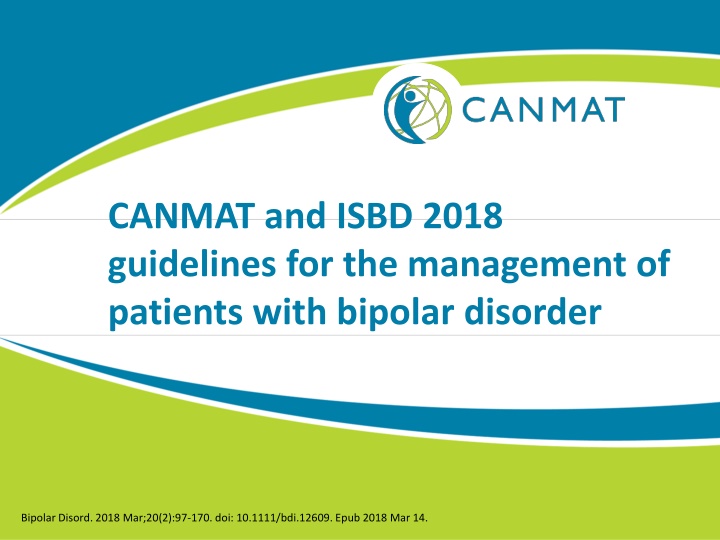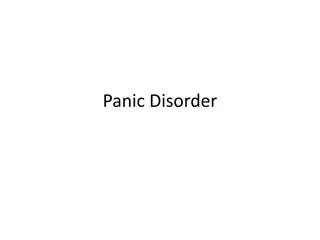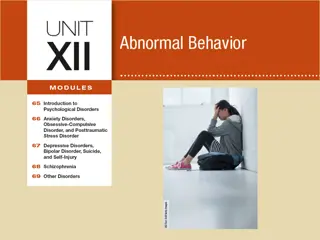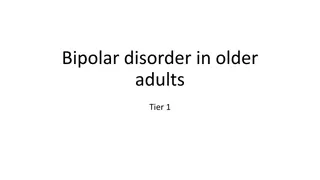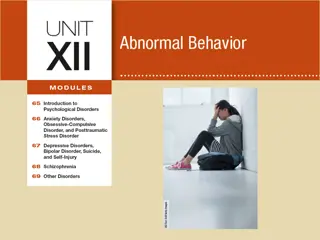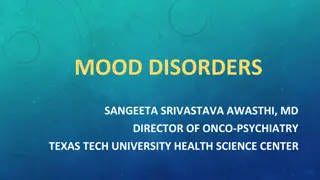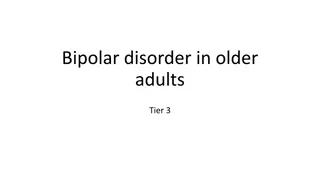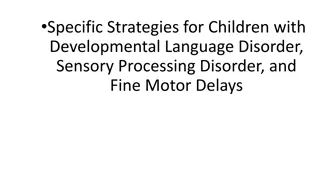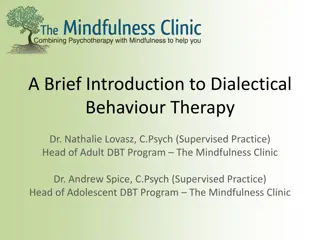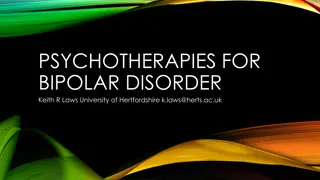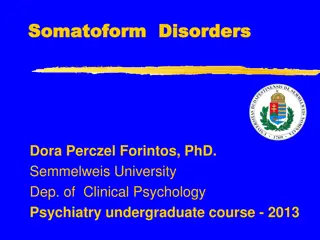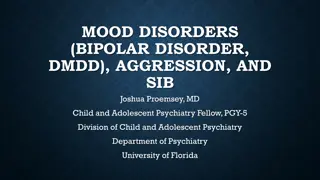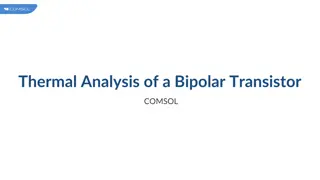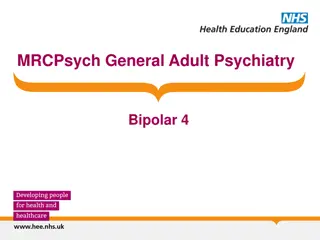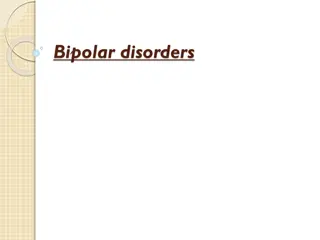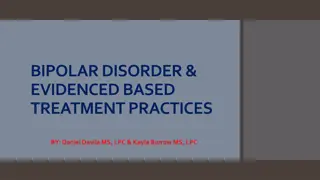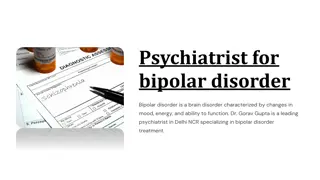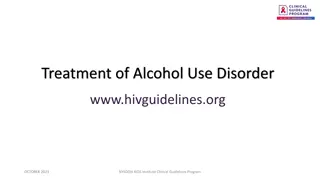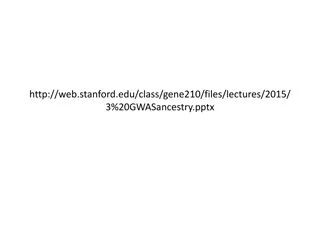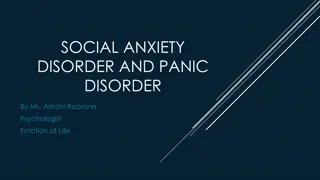Management of Bipolar II Disorder: Guidelines and Features
The content discusses the 2018 CANMAT and ISBD guidelines for managing patients with Bipolar II Disorder, covering clinical presentation, pharmacologic treatment, diagnostic criteria, and general considerations. It also explores the distinct features of Bipolar II Disorder, including prevalence rates, associated disability, and economic burden. Additionally, it highlights the diagnostic criteria for Bipolar II Disorder, differentiating between hypomania and major depression episodes. The DSM-5 criteria for mania versus hypomania are compared, emphasizing the key distinctions. The general considerations for interpreting recommendations in the context of Bipolar II Disorder are also addressed, shedding light on the research landscape and evidence quality.
Download Presentation

Please find below an Image/Link to download the presentation.
The content on the website is provided AS IS for your information and personal use only. It may not be sold, licensed, or shared on other websites without obtaining consent from the author.If you encounter any issues during the download, it is possible that the publisher has removed the file from their server.
You are allowed to download the files provided on this website for personal or commercial use, subject to the condition that they are used lawfully. All files are the property of their respective owners.
The content on the website is provided AS IS for your information and personal use only. It may not be sold, licensed, or shared on other websites without obtaining consent from the author.
E N D
Presentation Transcript
CANMAT and ISBD 2018 guidelines for the management of patients with bipolar disorder Bipolar Disord. 2018 Mar;20(2):97-170. doi: 10.1111/bdi.12609. Epub 2018 Mar 14.
Bipolar II Disorder: Content Clinical presentation of bipolar II disorder Pharmacologic treatment of bipolar II disorder General considerations for interpreting recommendations Acute management of bipolar II hypomania Acute management of bipolar II depression Maintenance treatment
Features of Bipolar II Disorder Lifetime prevalence in Canada (0.67%) is similar to BD I (0.87%) Diagnostic subtype is generally stable over time, but may be a prodrome of BD I in some patients Depressive phase usually predominates Associated disability is similar to BD I Similar rates of attempted and completed suicides Economic burden is ~4 times greater
Diagnosis of Bipolar II Disorder Diagnosis is based on 1 episode of hypomania 1 episode of major depression Absence of manic episodes Addition of DSM-5 mixed features specifier to hypomania
DSM-5 Criteria for Mania vs Hypomania Mania Hypomania (less severe) Criteria (more severe) Minimum timeframe for diagnosis 1 week 4 days No. of symptoms for diagnosis At least 3 At least 3 Grandiosity Yes Yes Decreased need for sleep Yes Yes More talkative Yes Yes Flight of ideas Yes Yes Distractibility Yes Yes Increased goal-directed activity Yes Yes Risky behaviour Yes Yes Marked impairment of social/occupational functioning Yes No Psychotic features Yes No May require hospitalization Yes No Adapted from DSM-5
General Considerations for Interpreting Recommendations Understudied relative to BD I Fewer studies Underpowered Lower quality evidence Often combined populations of BD I and BD II Studies that enrolled <50% of patients with BD II and did not report results separately are Level 4 evidence (expert opinion)
Acute Management of Hypomania General principles for assessing mania apply to hypomania Discontinue agents that can worsen or prolong symptoms, e.g. antidepressants and stimulants Initiate appropriate pharmacotherapy
Strength of Evidence for Acute Management of Hypomania Many standard medications for mania have not been studied in hypomania, including lithium and most antipsychotics Clinical experience suggests that all anti-manic medications are efficacious in hypomania Agent Evidence Level Divalproex N-acetylcysteine Quetiapine Only 4 agents have been studied in hypomania Suggestion of efficacy, but trials had significant weaknesses, e.g. small size, mixed samples of BD I and BD II, positive findings on only some outcomes Risperidone
Strength of Evidence and Treatment Recommendations for Acute Management of Bipolar II Depression Level of Evidence Agent First Line Quetiapine Sertraline* Venlafaxine* Lamotrigine Lithium Second Line ECT (adj) Tranylcypromine Ziprasidone# Fluoxetine* Ketamine (IV or sublingual) (adj)^ Pramiprexole (adj) Third Line EPA (adj) N-acetylcysteine (adj) T3/T4 thyroid hormones (adj) Agomelatine (adj) Bupropion (adj) Divalproex *: for patients with pure depression (non-mixed); # for patients with depression and mixed hypomania: ^: for severely ill/ treatment refractory patients; adj: adjunctive ECT: electroconvulsive therapy; EPA: eicosapentaenoic acid
Why is Lithium Recommended 2nd Line for Bipolar II Depression? Lithium was not superior vs. placebo in the only modern placebo-controlled parallel-group study in BD II1 Lithium was also less effective than venlafaxine in a 12-week RCT2 But in older trials: Lithium was as effective as sertraline and lithium + sertraline in a 16-week RCT (Level 2 evidence)3 As effective as lamotrigine in a single-blind 16-week trial4 Effective in 4 small placebo-controlled crossover studies in a mixed sample of BD I and BD II patients6-8 Discrepant findings could be explained by differences in serum levels (0.8-1.3 mEq/L in older trials) Demonstrated efficacy in relapse prevention in BD II9-12 These data, though mixed, justify recommending lithium as a 2nd line agent for BD II depression 1. Young AH et al. J Clin Psychiatry 2010;71:150-62; 2. Amsterdam JD et al. Br J Psychiatry 2016;208:359-65; 3. Altshuler LL et al. Am J Psychiatry 2017;174:266-76; 4. Suppes T et al. J Affect Disord 2008;111:334-43; 5. Donnelly EF et al. Am J Psychiatry 1978;135:552-6; 6. Goodwin FK et al. Arch Gen Psychiatry 1969;21:486-96; 7. Goodwin FK et al. Am J Psychiatry 1972;129:44-7; 8. Baron M et al. Arch Gen Psychiatry 1975;32:1107-11; 9. Kane JM et al. Arch Gen Psychiatry 1982;39:1065-9; 10. Fieve RR et al. Am J Psychiatry 1976;133:925-9; 11. Dunner DL et al. Arch Gen Psychiatry 1974;30:229-33; 12. Nierenberg AA et al. J Clin Psychiatry 2016;77:90-9.
Should Antidepressants Be Used in Bipolar II Depression? Continued concerns regarding safety: A meta-analysis compared rates of antidepressant- associated mood elevations in BD II, BD I, and MDD1 Significantly less frequent in BD II vs. BD I Almost exclusively hypomania switches rather than mania Switch rates were low even during antidepressant monotherapy or with high-risk agents (e.g. tricyclics, venlafaxine) ISBD task force report concluded that antidepressants risk-benefit was more favorable in BD II2,3 1. Bond DJ et al. J Clin Psychiatry 2008;69:1589-601; 2. Paccharotti I et al. Am J Psychiatry 2013;170:1249-62; 3. Baron M et al. Arch Gen Psychiatry 1975;32:1107-11.
Limited Evidence for Efficacy of Antidepressants in Bipolar II Depression Evidence for antidepressant monotherapy: Sertraline as effective as lithium + sertraline (Level 2) Venlafaxine more effective vs. lithium (Level 2) Bupropion as effective as sertraline and venlafaxine in a mixed sample of BD I and BD II patients1 Open-label data suggest efficacy for fluoxetine Maintenance data support venlafaxine and fluoxetine HOWEVER 1. Post RM et al. Br J Psychiatry 2006;189:124-31.
Limited Evidence for Efficacy of Antidepressants in Bipolar II Depression Paroxetine and bupropion no better than placebo in patients taking concomitant mood stabilizers Limitations of the available evidence: There are no PBO-controlled acute studies of antidepressant monotherapy in BD II Many antidepressants have not been studied at all Existing trials enrolled patients with non-mixed depression (generalizable to broader spectrum of BD II patients?) Significant trial weaknesses (e.g. low dosing of antidepressant and comparator drugs, lack of replication Inconsistent methodology and high thresholds in assessment of adverse events 1. Post RM et al. Br J Psychiatry 2006;189:124-31.
Role of Antidepressants in Bipolar II Depression? Recommendations restricted to specific antidepressants studied in BD II Bupropion, sertraline and venlafaxine are recommended as 2nd line monotherapy; fluoxetine 3rd line Any antidepressant, especially monotherapy, should be reserved for patients with pure depression and avoided in those with mixed symptoms or history of antidepressant-induced hypomania1 Avoid in rapid cyclers? Some studies report poorer outcomes2 but others do not3-6 BD II patients prescribed antidepressants must be educated on early-warning signs of hypomania and carefully monitored. 1. Pacchiarotti I et al. Am J Psychiatry 2013;170:1249-62; 2. Vohringer PA et al. J Clin Psychopharmacol 2015;35:605-8; 3. Amsterdam JD et al. Br J Psychiatry 2016;208:359-65; 4. Amsterdam JD et al. J Affect Disord 2009;112:219-30; 5. Amsterdam JD et al. J Clin Psychopharmacol 2013;33:420-4; 6. Amsterdam JD et al. Br J Psychiatry 2013;202:301-6.
Why is Lamotrigine Recommended 2nd Line for Bipolar II Depression? 2 negative trials in BD II depression:1 8-week trial of 221 BD II patients randomized to lamotrigine 200 mg/d vs. placebo 10-week trial of 206 BD I or BD II patients who received up to lamotrigine 400 mg/d Meta-analysis confirmed that lamotrigine was no better than placebo in BD II patients2 But several methodological short-comings: Slow titration (6 weeks in 8 week study) short time at target dose Target dose was low Higher placebo response rates 1. Calabrese JR et al. Bipolar Disord 2008;10:323-33; 2. Geddes JR et al. Br J Psychiatry 2009;194:4-9.
Reconciling Conflicting Data for Lamotrigine in Bipolar II Depression Lamotrigine monotherapy as effective as lithium (1.1 mEq/L) in a single-blind RCT with higher target dose (300 mg) and longer duration (16 weeks)1 Adjunctive lamotrigine showed effective in mixed groups of patients with BD I and BD II: Two large RCTs2 12-week open-label trial3 Robust efficacy in prevention of BD I or BD II relapse4,5 Lamotrigine is recommended 2nd line in BD II depression, particularly in patients who can tolerate a slow titration and delayed effect 1. Suppes T et al. J Affect Disord 2008;111:334-43; 2. Geddes JR et al. Lancet Psychiatry 2016;3:31-9; 3. van der Loos MLM et al. J Clin Psychiatry 2009;70:223-31; 4. Calabrese JR et al. J Clin Psychiatry 2000;61:841-50; 5. Calabrese JR et al. J Clin Psychiatry 2003;64:1013-24.
Agents Not Recommended or Requiring Further Study for Management of Bipolar II Depression Recommendation Agent Level of Evidence Not Recommended Paroxetine Cranial electrotherapy stimulation (CES) Dextromethorphan + quinidine Light therapy Lisdexamfetamine (adjunctive) Olanzapine Pioglitazone Pregnenolone (adjunctive) Celecoxib Levetiracetam s-adenosylmethionine Acetyl-L-carnitine + alpha-lipoic acid Modafinil (adjunctive) Repetitive transcranial magnetic stimulation (rTMS) Memantine No Specific Recommendation/ Requires Further Study Insufficient data
Maintenance Treatment of Bipolar II Disorder Goals of maintenance therapy: Prevent relapse Reduce subsyndromal symptoms Improve quality of life Selection of a maintenance agent should be informed by acute phase treatment
Strength of Evidence and Treatment Recommendations for Maintenance Treatment of Bipolar II Disorder Agent Evidence Level Quetiapine First Line Lithium Lamotrigine Venlafaxine Second Line Fluoxetine Carbamazepine Escitalopram Divalproex Other antidepressants Third Line Risperidone* No Specific Recommendation Olanzapine Insufficient data * Primarily for prevention of hypomania
